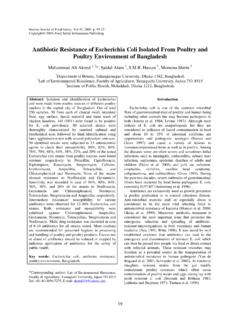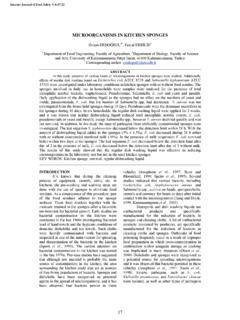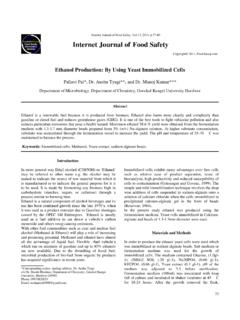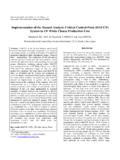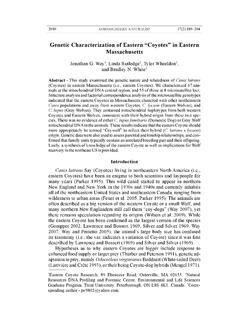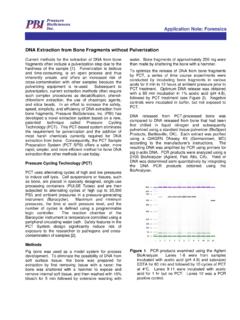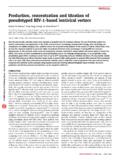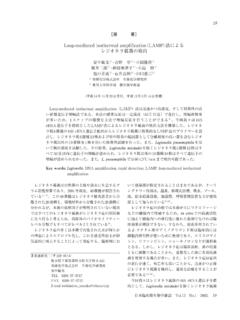Transcription of Enumeration of Clostridium estertheticum Spores …
1 115 Internet Journal of Food Safety, , 2010, p. 115-121 Copyright 2010, Food Safety Information Publishing Enumeration of Clostridium estertheticum Spores in Samples from Meat Plant Conveyors and Silage Stacks by Conventional and Real-Time PCR Procedures Xianqin Yang*, Colin O. Gill and Sampathkumar Balamurugan Agriculture and Agri-Food Canada Lacombe Research Centre, Lacombe, Alberta, Canada Introduction Spoilage of vacuum packaged raw meats by Clostridium estertheticum , Clostridium gasigenes or Clostridium frigidicarnis is accompanied by gas production which causes swelling of packs (Broda et al. 1999; 2000). However, only C. estertheticum has been found to cause gross swelling of vacuum packs at early times during storage at well maintained chiller temperatures (Moschonas et al.)
2 2010). That is apparently the type of blown pack spoilage that is seen most commonly in vacuum packaged raw meats (Yang et al. 2009a). Recovery of C. estertheticum from exudate or meat in blown packs, by direct plating or after enrichment of samples for psychrotolerant spore forming anaerobes is difficult and uncertain (Byrne et al. 2009). PCR methods have then been shown to be more reliable for detection of C. estertheticum in sample preparations or enrichment broths (Helps et al. 1999; Broda et al. 2003). Thus, in a study of the presence of C. estertheticum in samples obtained from carcasses and equipment at, and the environment of a meat packing plant, isolates were recovered from some faecal but few of other types of samples (Broda et al.
3 2002). In contrast, when enrichment cultures of samples from packing plants in New Zealand and Ireland were tested for the presence of C. estertheticum by PCR procedures the organism was detected in substantial fractions of the samples from faeces, hides, lairages and the carcass dressing facilities (Boerema et al. 2003; Broda et al. 2009; Moschonas et al. 2009). However, the organism was detected in few samples from carcass breaking facilities. The time required for blown pack spoilage caused by C. estertheticum to become apparent is dependent on the storage temperature and the initial numbers of the organism on the product (Moschonas et al. 2010). PCR procedures for Enumeration as well as detection of C. estertheticum in samples from meat plants are then desirable, to allow the risks of blown pack spoilage developing in product to be assessed from tests of samples obtained at packing plants.
4 Abstract: A real-time PCR procedure for Enumeration of Spores of Clostridium estertheticum , the organism that causes blown pack spoilage of vacuum packaged chilled raw meats was developed. The relationship between cycle threshold (Ct) values and log numbers of Spores in samples from which DNA was extracted was linear in the range 3 to 3x105 Spores (R2> ). Samples collected from conveyor belts for primal cuts at a beef packing plant and from silage stacks were processed for Enumeration of C. estertheticum Spores by cultivation and real-time PCR. The organism was not recovered from any samples using culture method; but PCR results indicated that Spores were present in 35 of 63 samples from conveyor belts and 4 of 38 silage samples, at numbers between 3 and 108/sample and 5 and 119/g, respectively.
5 Key words: Clostridium estertheticum , spore Enumeration , meat conveyors, silage * Corresponding author. mailing address: 6000 C & E Trail, Lacombe, Alberta, Canada T4L 1W1, Tel: +1-403-782-8569, Fax: +1-403-782-6120, E-mail: 116 Although a semiquantitative method for enumerating C. estertheticum Spores from PCR products was described by Helps et al. (1999), such methods have been superseded by quantitative PCR. Therefore a quantitative PCR procedure for Enumeration of C. estertheticum Spores was developed. The quantitative PCR and direct plating procedures were used for the Enumeration of C. estertheticum Spores recovered from beef packing plant conveyors and silage stacks. The conveyors were sampled at a plant that had previously experienced incidents of blown pack spoilage. The numbers of Spores recovered from the conveyors could be expected to reflect the numbers present on the meat at the time of packaging (Gill et al.)
6 2001). Samples from silage stacks were sampled because C. estertheticum ferments sugars and lactic acid similarly to Clostridium tyrobutyricum, the organism that causes late blowing of cheese (Le Bourhis et al. 2007; Yang et al. 2009b). The origins of the C. estertheticum Spores found in the faeces and on the hides of slaughtered animals are not well understood. However, a major source of the C. tyrobutyricum found in milk is the silage fed to animals (Julien et al. 2008). It therefore seemed possible the silage might be similarly important as a source of C. estertheticum on vacuum packed beef derived from animals held in feed lots for fattening before slaughter. Materials and Methods Preparation of spore suspensions. C. estertheticum ATCC 51377 was grown in Hungate tubes, in media that were prereduced by flushing with an oxygen free mixture of 80% N2, 10% CO2 and 10% H2 (Air Liquide Canada Inc.
7 , Red Deer, Alberta, Canada). Cultures grown in Reinforced Clostridial Medium (RCM; Oxoid, Mississauga, Ontario, Canada) at 10 C for 3 days were used to inoculate Peptone Yeast Extract Glucose Starch broth (PYGS), prepared in accordance with Lund et al. (1990). PYGS cultures were incubated at 10 C for up to 5 weeks. During the fourth week of incubation, wet mounts of the cultures were examined daily under phase contrast illumination. Spores were harvested when Spores were observed in 50% of the cells. To prepare spore suspensions, each sporulating culture was centrifuged at 7500 x g for 20 min. The pelleted cells were washed four times by resuspension in 10 ml of ice-cold (w/v) NaCl and centrifugation as before. After washing the pellet was again suspended in 10 ml of NaCl solution, and the suspension was subject to three rounds of sonication for 5 min then washing, as before.
8 Suspensions were sonicated using a Model 100 Sonic Dismembrator (Fisher Scientific, Ottawa, Ontario, Canada). The pellet obtained after the final sonication treatment was resuspended in 5 ml of NaCl solution, and the suspension was stored at -80 C until used. To determine the number of Spores in each suspension, serial ten-fold dilutions of the suspension in NaCl solution to 10-6 were prepared. The numbers of Spores in appropriate dilutions were counted by placing 10 l of each dilution in a Petroff-Hausser counting chamber (Model 3900; Hausser Scientific, Horsham, PA, USA) and viewing the Spores under phase contrast illumination with 400 x magnification. The Spores in dilutions containing between 100 and 200 Spores in 16 squares, each measuring 50 x 50 m, were counted.
9 In addition, appropriate dilutions of spore suspensions were incubated at 80 C for 10 min to activate Spores . Triplicate plates of Columbia Blood Agar (CBA) were spread with ml portions of the activated spore suspensions, and the plates were incubated at 10 C for 3 weeks under anaerobic atmospheres generated using BBL GasPak anaerobic System Envelopes (Becton Dickinson, Sparks, MD, USA). Colonies on plates bearing between 25 and 250 colonies were counted. Extraction of DNA from C. estertheticum Spores . For removal of extraneous DNA, 1 ml portions of spore suspensions which contained about 109 Spores /ml were centrifuged at 7500 x g for 20 min. Each pellet was resuspended in 500 l of a lytic solution containing lysozyme (Sigma-Aldrich, Oakville, Ontario, Canada) at 10 mg/ml and DNase I (Sigma-Aldrich) at 2 mg/ml.
10 After incubation of the suspension at 37 C for 1 h, 10 mg of trypsin (Sigma-Aldrich) was added and the suspension was incubated for a further h. The enzymes were inactivated by incubating the suspension at 80 C for 10 min, then the Spores were washed three times by resuspension in sterile distilled water and centrifugation. The washed Spores were resuspended, and incubated at 37 C for 1 h in a solution containing 8 mol l-1 urea and 40% (w/v) sodium thioglycolate, then washed three times by centrifugation and resuspension in distilled water, to remove spore coats (Durban et al. 1974). DNA was extracted from the decoated Spores using the DNeasy Blood and Tissue Kit (Qiagen, Mississauga, Ontario, Canada), by the method for Gram positive bacteria specified by the manufacturer, with some modification.


